wrestling / Columns
The Magnificent Seven: The Top 7 US Wrestling Stars Of Last The Last Thirty Years
I’ll be the first to admit that there is no definitive way in which to rank professional wrestlers. If all you look at is technical ability, names lke Dean Malenko and Lance Storm have a place in the conversation of all-time greats. If all you care about is ability to draw, then no one can even approach the Hulk Hogans and Steve Austins of the wrestling world. If you prioritize promos and character work above all else, guys like Jake Roberts and Roddy Piper own the field.
To me, the best, if inherently flawed, approach to evaluating wrestlers rests in a combination of these factors—physical and vocal skills, the ability to draw, impact on wrestling history, myriad intangibles, and, of course, personal opinion. This combination of factors allows deserving parties such as Andre the Giant, Chris Jericho, The Undertaker, Dusty Rhodes, John Cena, Ricky Steamboat and Eddie Guerrero to all have their places in this same conversation (though all of those parties landed in my high “honorable mentions” without quite cracking the countdown).
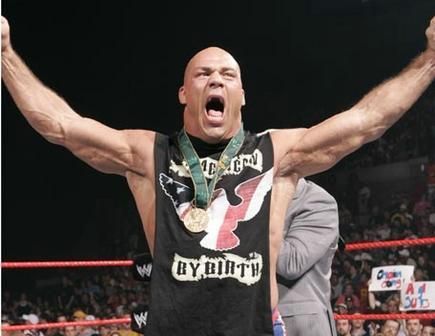
#7. Kurt Angle
Between his natural athleticism and competitive streak, his peerless amateur wrestling pedigree, his charisma and talking game, coming along in the thick of the red hot Attitude Era, and his ability to adapt his style when playing different roles for different promotions at different times, Kurt Angle truly had all of the tools necessary to land on anyone’s short list of the greatest wrestlers of all time. Whether he was working as a comedic heel, a patriot hero, or a wrestling machine, Angle is a rare talent who rose to the top of professional wrestling within his first year in the business, and remained an elite all-around performer for the better part of two decades to follow.
Angle’s greatest asset may have been his intensity—a quality that saw him work through injuries, cut an alarming pace in iron man matches and other marathons, and deliver moonsaults off the top of steel cages. This same quality has also limited his legacy to an extent, though—defecting from the brightest lights of WWE to the lesser stage of TNA when he wouldn’t accept the former promotion diminishing his role based on injuries, and then getting himself into trouble with pain killers and alcohol when he struggled to recognize his own limits.
Despite the missteps that kept Angle from ranking higher on this list, the fact remains that over the course of two decades he has delivered truly great matches and programs, paired with the likes of Chris Benoit, Steve Austin, Brock Lesnar, Shawn Michaels, Samoa Joe, AJ Styles, and many, many others. He’s a master technician, deceptively strong, an underrated aerial artist, and more than capable of holding his own in an entertaining brawl. One of wrestling’s most versatile and skilled, stars, Angle is truly an all-time great.
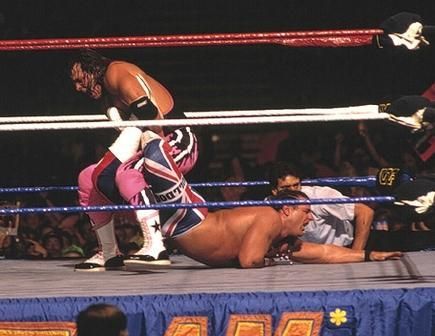
#6. Bret Hart
I imagine that this may be one of the more controversial placements on this countdown. Folks who love Bret Hart will skewer me for not placing the greatest technician of his era in my top two or three, besides questioning why one of the WWF’s all time great international draws isn’t getting his just due. Folks who criticize Hart for not having the promo skills or domestic drawing power as others on this list may question why he’s making the top seven at all.
I’m a Bret Hart mark through and through. I was nine years old when he won his first world title, and growing up a skinny kid and an underdog, Hart was my guy. Thus, I can’t imagine a list of all-time greats that doesn’t give him a nod; just the same, I also consider myself a realist about Hart’s limitations, and the fact that his star shone brightest in the time in between Rock N Wrestling and Attitude, and thus it’s difficult to place him above the top stars of those periods.
All of that said, Hart was one of the most committed realists in wrestling. He was a brilliant psychologist who sold better than anyone this side of Ricky Steamboat while still cutting a blistering pace for the duration of his career. On top of all of that, he has the rare claim of a twenty-year career without ever giving any other wrestler a meaningful injury—a record that’s virtually without peer, particularly when you consider that Hart worked more than his share of long main event matches. Whether he was establishing a prototypical tag team with the Hart Foundation, cementing the Intercontintal Championship’s place as a the worker’s strap, offering technical legitimacy to the WWF world title, fronting a Canadian heel super stable, or making the most of WCW’s inane booking, Hart proved himself time and again as a truly special talent in the wrestling world.

#5. Hulk Hogan
When it comes to main event relevance at key periods in American wrestling history, Hulk Hogan is without peer in any era. He was the runaway top face in WWF’s wildly successful 1980s into early 1990s run. Then he became the top heel in WCW’s most successful period, atop the NWO juggernaut—accomplishing an incredibly rare feat to be that successful as both a top-tier face and heel. Add to that the greatest nostalgia run in WWE history from WrestleMania 18 to WrestleMania 19, and Hogan is a more than worthy candidate for the top spot in this countdown.
With all of that said, I’m limiting Hogan to fifth on this list on account of the quality of his in-ring performances. I’m not among the haters who will tell you The Hulkster sucked. On the contrary, he worked a style that appealed to a general audience, that most importantly included kids. Moreover, he did have some objectively very good matches opposite Randy Savage, The Ultimate Warrior, and a handful of others. And for all of those fans of Hogan’s work in Japan, yes, he could chain wrestle. Just the same, The Hulkster’s workrate was never a major factor in his success in the US, where he depended far more on charisma and sheer physical strength to achieve iconic programs and matches with guys like Andre the Giant, Sgt. Slaughter, and Sting—matches that fans can recognize as big-time main events, but that hardly anyone would argue were great in-ring performances when watched in a vacuum.
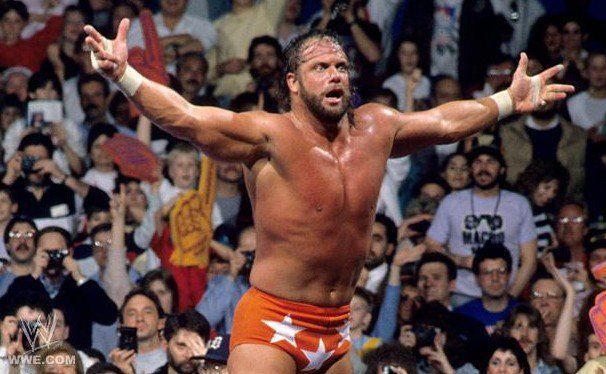
#4. Randy Savage
Randy Savage is an iconic figure in professional wrestling, and would probably rate higher in this countdown if he had ever been fully trusted as the man in a major wrestling promotion. Instead, Savage fell victim to almost constantly playing second fiddle to Hulk Hogan in both the WWF and WCW, and later, in the latter case, being just one of the biggest names amidst a constellation of superstars alongside guys like Sting, Lex Luger, Ric Flair and Kevin Nash.
With all of that said, there is a very real argument that Savage was the best all-around pro wrestler of the last thirty years—wildly intense, a consistently great promo man, and an easy pick for top five brawler, seller, and technician. Add onto that his iconic aerial offense—the flying elbow drop and double axehandle of the top rope—and you have a guy who was remarkably good from the mid-eighties to late-nineties. The only real knock on him, aside from never getting a sustained push as the biggest name in a major promotion, is his insistence on planning, choreographing, and rehearsing big matches. Just the same, it’s hard to argue with this tendency when it led to WrestleMania classics opposite Ricky Steamboat, Hulk Hogan, The Ultimate Warrior, and Ric Flair, in addition to a very good run in WCW, that included putting Diamond Dallas Page on the map as a main event talent.
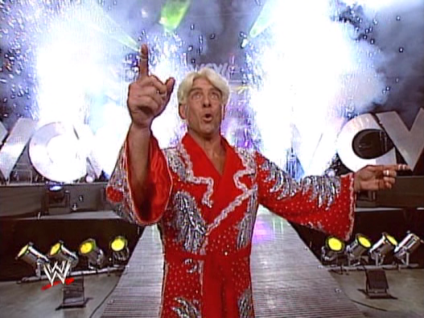
#3. Ric Flair
Ric Flair was quite arguably the greatest traveling NWA world champ of all-time. The Nature Boy spanned territories, pulling great matches, often up to an hour long, out of regional talents, doing his best to convince the fans in every given town that their guy was inches from claiming the world title for himself.
The past thirty years have seen that NWA model go from the dominant paradigm in wrestling, to less important, to a fallen dynasty in which the Alliance of promoters and its championship still exist but are hardly relevant to anyone but the most hardcore of fans. Just the same, it was Flair who dominated the strap in its final glory days and Flair who transitioned from traveling champ to the icon of Jim Crockett Promotions and WCW, who also had himself a very good run in early nineties WWF, a good coda to his career in 2000s WWE, and a probably-ill-advised but reasonably entertaining stint with TNA after all of that. Along the way, he contributed to so many all-time great wrestling programs opposite people like Dusty Rhodes, Ricky Steamboat, Sting, Randy Savage, Hulk Hogan, and plenty of others.
Flair’s longevity, charisma, promo skills, and technical ability all combine to make him a frontrunner in any evaluation of wrestling’s top talents, and I can certainly understand those who would want to rank him number one on this particular countdown. That said, there were two particular men who I felt edged him out.
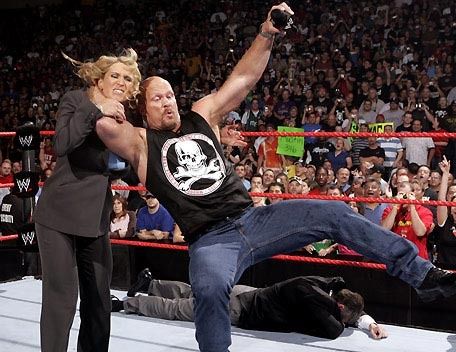
#2.Steve Austin
If this countdown were to consider only main event runs and to evaluate wrestlers pound for pound, thus taking longevity out of the equation, I may well have ranked Stone Cold Steve Austin in the number one spot. During Austin’s run from 1998 to 2003 (and arguably starting a year or even two years earlier) he was probably hotter than any wrestler has ever been before or since, doing his best work as the greatest anti-hero in wrestling history, and folding in a very good (if ill-advised for business) heel run as well. Austin’s unique brand of charisma was perfectly suited to define The Attitude Era, and on top of that he was an excellent worker—yes, a brawler, but also an underrated technician.
Austin’s work in the last five years of his active, in-ring career was strong enough to earn him a top five spot on this countdown, but it’s the work that preceded that that shores up his place at number two, including a banner rookie year in WCCW where he warred with his mentor, Chris Adams, followed by an excellent mid-card run in WCW, highlighted by his reigns with the US and TV championships, and a criminally short-lived pairing with Brian Pillman as The Hollywood Blonds. Austin accrues a few extra bonus points for his cup of coffee with ECW, where raised hell primarily via anti-Eric Bishoff promos.
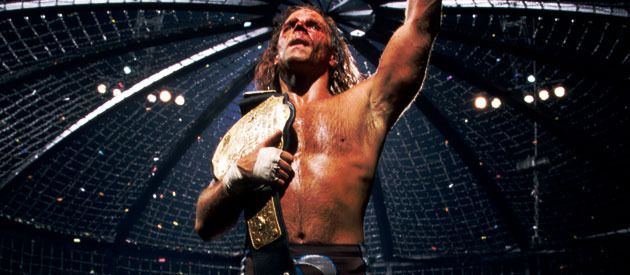
#1. Shawn Michaels
As I wrote earlier, I’m a Breg Hart guy, thus it is not easy for me declare Shawn Michaels the number one wrestler of the last thirty years. Just the same, the man’s work speaks for itself via iconic WrestleMania, Royal Rumble, and Survivor Series performances, the innovation of Degeneration X, and, perhaps most importantly of all, his remarkably strong eight-year run after a back injury had first retired him, during which time he added a World Heavyweight Championship , a WrestleMania main event, and simply phenomenal one-on-one encounters with Chris Jericho, Kurt Angle, The Undertaker, Ric Flair and plenty of others to his resume.
Shawn Michaels was a great high-flyer, a superb underdog brawler, a supreme technician, an excellent promo man, and the chosen one to carry the strap during some of the WWF’s otherwise darkest periods (particularly the mid-1990s). When you talk about all-around great wrestlers from the past thirty years, the buck stops with Shawn Michaels.
What are your picks for the top seven wrestlers in the US over the last thirty years? Andre the Giant? Chris Jericho? The Undertaker? Dusty Rhodes? John Cena? Ricky Steamboat? Eddie Guerrero? Rey Mysterio? Sting? They were certainly among my long list of runners up. Let us know what you think in the comments section. See you in seven.
Read more from Mike Chin at his website and follow him on Twitter @miketchin.







